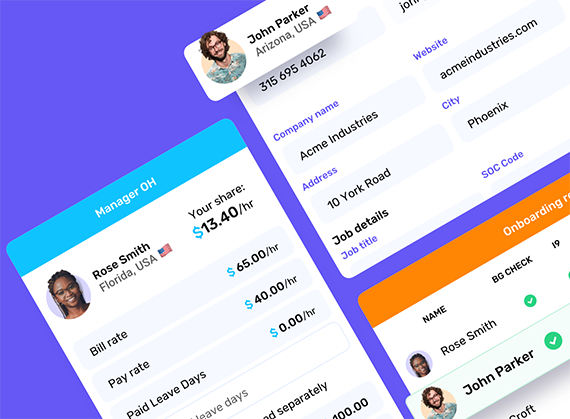In an increasingly dynamic labor market, contingent workforce programs are gaining traction as organizations seek flexible, scalable talent solutions. Yet, even with the undeniable benefits, program leaders often face the challenge of driving adoption across the company. How do you encourage hiring managers, department heads, and other stakeholders to embrace contingent labor as a critical component of the workforce strategy?
Here’s how program leaders can grow adoption of contingent workforce programs, ensuring buy-in from key players and alignment with broader business objectives.
7 Steps to Improve CW Program Adoption
1. Educate Stakeholders on the Benefits
The first step in driving adoption is education. Many hiring managers may not fully understand the advantages of contingent labor, such as the ability to scale teams quickly, access specialized skills, and reduce overhead costs.
To build momentum, hold educational sessions, webinars, or one-on-one meetings where you explain the tangible benefits of a contingent workforce program:
- Flexibility: Contingent workers can fill temporary needs during peak demand or special projects.
- Cost Efficiency: By avoiding long-term contracts and traditional employee benefits, organizations can save on costs.
- Access to Expertise: Temporary talent pools often contain highly specialized skills that may not be available in your existing full-time workforce.
Highlight specific success stories within your organization or industry where contingent labor has driven significant results.
2. Align the Program with Business Goals
Ensure your contingent workforce program is positioned as a strategic tool that aligns with the organization’s overarching goals. This includes:
- Growth Objectives: Show how contingent labor supports scaling operations quickly and meeting business growth targets.
- Innovation and Agility: Demonstrate how contingent workers bring fresh perspectives and niche expertise that accelerate innovation and improve agility.
- Risk Management: Emphasize how using contingent labor can help mitigate risks related to sudden project demands or economic shifts, giving your company the agility to adapt.
By tying the program to outcomes that matter to each department, you’ll make it easier for leaders to see contingent labor as a value-add rather than a cost.
3. Simplify the Onboarding and Hiring Process
A common barrier to adoption is the perception that managing contingent workers adds complexity to HR processes. If program leaders streamline onboarding and hiring processes, adoption is more likely to grow.
Use technology, such as an Employer of Record (EOR) platform, to remove administrative headaches associated with contingent labor. An EOR can handle compliance, payroll, insurance, and taxes, freeing hiring managers to focus on project outcomes rather than paperwork.
Offer self-service portals where hiring managers can easily request contingent workers, track candidates, and initiate onboarding in a few clicks. By simplifying the process, you’ll remove friction points that discourage adoption.
4. Develop Strong Partnerships with Vendors
A key component of any successful contingent workforce program is building strong partnerships with staffing agencies and EOR vendors. These agencies provide the talent you need, but they also offer deep insights into labor market trends, candidate expectations, and compliance requirements.
Work with agencies to create a customized approach that ensures:
- Quality of Talent: Set clear standards for the skill level and experience you require from contingent workers.
- Speed of Delivery: Establish clear timelines and expectations around how quickly candidates can be sourced and onboarded.
- Compliance and Risk Mitigation: Ensure that your staffing agencies are well-versed in relevant employment laws and provide candidates that meet all compliance standards. Or use an EOR to consolidate your agencies, ensuring compliance with laws through one vetted EOR provider.
Strong relationships with your staffing agencies can make it easier to deliver on contingent labor needs quickly and efficiently.
5. Foster Internal Champions
Find champions within your organization who already see the value of contingent labor and can advocate for the program across departments. These champions could be department heads, HR leaders, or project managers who have successfully utilized contingent workers in the past.
Leverage their success stories to create a ripple effect. When other departments see the positive impact contingent labor has had on productivity, innovation, or cost-savings in another area, they’re more likely to consider adopting the program themselves.
Encourage champions to share best practices, offer mentorship, and support other teams as they begin working with contingent labor.
6. Track Success and Communicate Wins
Adoption often hinges on demonstrating measurable success. Develop KPIs that capture the value of your contingent workforce program, such as:
- Cost savings: Track how much has been saved by using contingent labor versus hiring full-time employees.
- Project outcomes: Measure project completion rates, quality, and speed when contingent workers are involved.
- Employee satisfaction: Conduct surveys to understand how contingent labor has contributed to overall team satisfaction and morale.
Once you have data, share it widely. Regularly communicate “big wins” to senior leadership and across departments. When stakeholders see the positive impact contingent labor is having on the company’s bottom line and goals, they will be more inclined to support and adopt the program.
7. Continuously Evolve Your Program
Finally, a successful contingent workforce program is not static. It should continuously evolve based on market trends, internal feedback, and company goals. Conduct regular audits of your program’s performance and seek feedback from hiring managers and contingent workers alike.
Stay updated on employment regulations and best practices, especially as laws around temporary work and gig economy employment shift. Investing in partnerships with Employer of Record (EOR) providers can help ensure compliance while keeping you agile and responsive to changes in the labor market.
By continuously refining your program, you demonstrate that the organization is committed to maintaining a high-quality and adaptable contingent workforce, making it easier to grow adoption over time.
Conclusion
Growing adoption of your contingent workforce program requires a mix of education, strategic alignment, and process simplification. By demonstrating the value contingent workers bring to the organization and removing the barriers to adoption, you can build a more flexible, cost-effective, and innovative workforce solution that meets your organization’s evolving needs.





